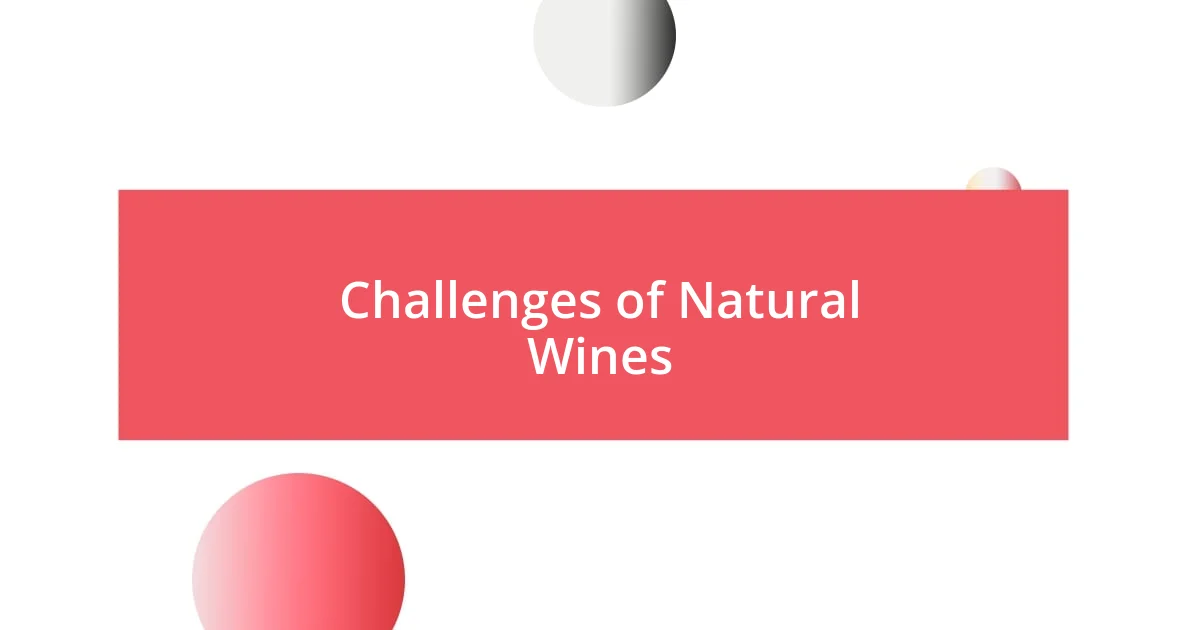Key takeaways:
- Natural wines are produced with minimal intervention, highlighting unique flavors and characteristics influenced by the vineyard’s terroir and winemaker’s philosophy.
- Food pairing with natural wines emphasizes matching intensity, embracing acidity, and celebrating seasonal choices, enhancing the overall dining experience.
- While natural wines offer authenticity and lower sulfites, they pose challenges in consistency, availability, and understanding labeling, making the selection process an adventure.

Understanding Natural Wines
Natural wines are fascinating, and I feel an undeniable connection to them. These wines are often produced with minimal intervention, meaning that the grapes are grown organically or biodynamically, and fermentation relies on wild yeasts. When I first sipped a natural wine, I was struck by its unique flavor profile—something that felt deeply rooted to the vineyard’s soil. Have you ever tasted a wine that seemed to transport you to the very place it was made?
The beauty of natural wines lies in their unpredictability. Each bottle can be a little different, shaped by the climate, the harvest, and even the winemaker’s philosophy. I remember a moment at a small wine festival when a seller opened a bottle that had a slight effervescence, unlike anything I’d encountered before. It was the perfect reminder that wine isn’t just a beverage; it’s an experience filled with surprises and stories. How often do we drink a wine and truly consider the journey it undertook to reach our glass?
Beyond the taste, there’s a philosophy that resonates with me when it comes to natural wines—they embrace imperfections and celebrate authenticity. This perspective invites us to rethink our relationship with wine. It makes me wonder: Aren’t we all a bit like natural wines, shaped by our surroundings and experiences? The next time you pour a glass, consider the story behind it, and you’ll find a deeper appreciation for what’s in your glass.

Characteristics of Natural Wines
Natural wines possess a distinctive character that sets them apart from conventional wines. For me, the most striking feature is the lively complexity that comes from using wild yeasts. I recall an evening spent with friends where we each brought a bottle of natural wine. The one I chose had an earthy undertone, mingling beautifully with floral notes. It sparked a lively discussion about how wild fermentation shapes the wine’s personality, creating an experience that feels alive in your glass.
Another defining characteristic is the lower level of sulfites compared to commercial wines. This often results in a more vibrant and expressive flavor profile. I often feel a sense of adventure when I open a bottle, as each one can have a unique aroma that shifts from the first sip to the last. Just last week, I opened a natural white wine that evolved from bright citrus to velvety stone fruit in moments. Have you ever noticed how certain wines tell a story that unfolds with every taste?
Color and clarity also play a significant role in identifying natural wines. Unlike filtered wines that often appear crystal clear, natural wines can be cloudy or hazy, showcasing their authenticity. I found joy in this when I attended a tasting where the host proudly displayed a beautiful orange wine. Its rich, golden hue was a testament to its unfiltered nature, and every sip captured the essence of the fruits and soils from which it originated.
| Characteristic | Description |
|---|---|
| Use of Wild Yeasts | Results in unique, complex flavors. |
| Low Sulfite Levels | Often more vibrant, allowing the wine’s character to shine. |
| Cloudy Appearance | Indicates minimal processing and a focus on authenticity. |

Food Pairing with Natural Wines
Pairing food with natural wines can feel like a delightful adventure, one that transcends traditional notions of wine and food matching. I vividly remember a summer evening spent with friends, where we gathered over a selection of natural reds. We paired one earthy bottle with a rustic pizza topped with mushrooms and fresh herbs. The wine’s vibrancy elevated the flavors of the dish and those candid moments around the table are ones I cherish. It prompted me to realize how natural wines can highlight, rather than overpower, the essence of what’s on the plate.
When it comes to natural wine and food pairings, there are several guiding principles I’ve come to appreciate:
- Match the intensity: Light wines, like a crisp natural white, work beautifully with delicate dishes such as grilled fish or salads.
- Embrace acidity: Natural wines often showcase bright acidity, making them perfect companions for rich cheeses or tomato-based dishes.
- Contrast flavors: Occasionally, a bold natural red can harmonize remarkably with spicy foods, balancing heat with depth.
- Seasonal choices: Celebrate what’s fresh and in season! I’ve found that local, seasonal meals often meld harmoniously with the natural wines produced in their region.
By honoring the synergy between our food choices and the wine in our glass, each meal becomes a shared experience, rich with flavor narratives.

Benefits of Choosing Natural Wines
Natural wines offer a refreshing alternative to their conventional counterparts, primarily because they embody a more authentic expression of their terroir. For instance, I once savored a bottle from a small vineyard nestled in the hills, and it transported me to that very place with every sip. It was as if I could taste the sun-soaked soil and the care of the winemaker. How often do we get to experience such a direct connection to the land through wine?
Another remarkable benefit is the greater health aspect associated with natural wines. With significantly lower sulfites and no added chemicals, many people, including myself, often find they wake up without the usual hangover headaches after enjoying a glass. I remember a gathering where a friend, sensitive to sulfites, shared her delight at being able to indulge in natural wines without feeling the dreaded aftereffects. Isn’t it liberating to enjoy wine without worrying about the next day?
Lastly, choosing natural wines often means supporting smaller, sustainable producers who prioritize ethical farming practices. I recall visiting a charming winery that practiced biodynamic farming, where every aspect of their process felt deliberate and connected to nature. By opting for their wines, I felt like I was part of a larger movement advocating for more sustainable agricultural practices. Isn’t it wonderful when our choices can impact the world positively?

Challenges of Natural Wines
Navigating the world of natural wines presents its unique challenges, particularly in terms of consistency and reliability. I recall opening a highly recommended bottle one evening, only to find it unexpectedly cloudy and slightly off. This experience made me realize that while natural wines embrace imperfection and spontaneity, that can sometimes lead to a less predictable tasting experience. Isn’t it intriguing how this unpredictability can shift our expectations and experiences as wine enthusiasts?
Another hurdle is the limited availability of natural wines, especially outside of niche wine shops or special markets. There have been times when I’ve craved a specific bottle, only to discover it was sold out or only produced in tiny quantities. This scarcity can evoke a sense of longing, and it sometimes feels like a treasure hunt. Have you ever felt that excitement while searching for something unique, knowing that not everyone will have access to the same gem?
Furthermore, deciphering labels and understanding what makes a wine “natural” can be bewildering. During one of my tastings, I found myself questioning the various certifications and terminology used by producers. Terms like “biodynamic” and “organic” can vary significantly in meaning, leaving me scratching my head at times. It begs the question: how do we truly know what we’re getting in the bottle? This search for clarity can sometimes be daunting, but it also deepens our appreciation for the complexity and unique stories behind each wine.

Tips for Selecting Natural Wines
When selecting natural wines, I often start by asking for recommendations from trusted sources. There’s something truly special about hearing a sommelier or a fellow enthusiast passionately describe their favorites; their enthusiasm often leads me to wines I might never have considered. Have you ever noticed how a well-told story about a wine can make you eager to try it?
Next, I pay attention to the producer’s story. I remember discovering a small vineyard run by a family that had been farming for generations. Learning about their sustainable practices and commitment to natural methods not only enhanced my appreciation but also made me feel a direct connection to the bottle. Knowing the heart and soul behind the wine elevates the experience, doesn’t it?
Lastly, I find it helpful to explore lesser-known varietals. Sometimes, stepping away from the usual cabernets and chardonnays opens up a world of unique flavors. I once tasted a skin-contact white that took me by surprise with its rich, textured profile—it was unlike anything I’d ever had. Isn’t it exhilarating to discover new taste sensations that challenge your palate and expand your understanding of what wine can be?

Personal Experiences with Natural Wines
It’s fascinating how my experiences with natural wines have unfolded at unexpected moments. One evening, I shared a bottle of orange wine with friends at dinner, and the vivid flavors sparked deep conversations and laughter that lingered long after the last sip. I mean, isn’t it remarkable how a bottle can merge strangers into friends, creating unforgettable memories around the table?
I still remember my first encounter with a pet-nat—a naturally sparkling wine. As I popped the cork, the lively fizz surprised me, not just in taste but in the sheer joy it brought to the occasion. Watching everyone’s faces light up with curiosity and delight reminded me of how wine can serve as an icebreaker, transforming an ordinary night into something truly special. Have you ever experienced that bubbly magic at a gathering?
Then there was the time I visited a vineyard where they only produced natural wines. Walking through the lush vines, I could feel the passion and dedication of the vineyard owner. As she shared her vision of working in harmony with nature, I felt an emotional connection to the craft: these wines weren’t just beverages; they were stories bottled up. It struck me that every sip carried not just flavor but also the essence of the land and the care put into each vineyard. Isn’t it incredible how wine can connect us to its roots, quite literally?















